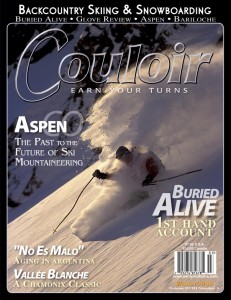
Reprinted from Couloir Magazine, Vol. XVIII-5, Winter 2006
© 2006
Very quickly, the ability to move ended. As the snow built up around my torso I squirmed to maintain some sense of mobility, but it was futile.
Then silence.
I took a breath, drawing deeply on the mouthpiece of an AvaLung, listening to the sound of the valve controlling the direction of airflow, through the tube, and deep into my lungs. I held it for a moment, listening to the quiet, then exhaled to another pause in the song that was to be my burial companion, a mixture of silence, air rushing down a tube, and, depending on the depth and rate at which I drew or expelled air, the sound of the valve, resonating low and thoughtful like an oboe.
I’d been forewarned that others before me had found the solitary, musical note of the AvaLung’s valve to be a source of reassurance. They were right. I had several other sources of reassurance to boot. Most importantly that this was a controlled exercise, and not a real burial in a real avalanche. Ostensibly this was a ski junket to check out Black Diamond’s new telemark binding, the O1. However, the last line of the email invitation was ominous, saying, “we’d like to bury you when you’re out here.”
Silly me. I accepted.
Besides the basic knowledge of knowing I could cry “Uncle” anytime I wanted, I also had on several extra layers of clothing, consisting of two layers of wool on my legs, wool, Dri-Clime fleece and down around my torso and arms, a layer of Schoeller over all that, plus a wool beret and neoprene face mask. On my feet I had opted for a pair of oversized, felt lined Sorell boots, and over all of that was a one-piece Gore-Tex shell that provided a final barrier to the snow. Before being buried in the snow, I was toasty.
Thank God I had only been asked to experience being buried, not also to be a guinea pig for hypothermia data. That level of service included the additional honor of wearing a rectal probe for monitoring core temperature, swallowing an esophageal probe, and freezing. As it was, I only had probes attached to my shoulders, waist and forehead, plus probes on three of my fingers. From wires attached to these sensors Dr. Colin Grissom (the medical doctor running the experiment) could monitor my pulse, breathing rate, breathing volume, level of oxygen saturation in my blood, and percentage of carbon dioxide (CO2) inhaled and exhaled.
That wasn’t the end of my list of assurances or conveniences for being buried. Besides all the above, next to my face was a walkie talkie. Any time I decided I’d had enough I could simply say, “Dig me out,” and the team would begin to unbury me. More importantly, it was my link and reminder that this was only a test as the silence would be interrupted every five minutes to tell me how things looked on the medical front, and ask if I was okay. It had also been determined beforehand that I wasn’t expected to set any records for length of burial, and 60 minutes was the proposed limit.
Silly me. I agreed again.
Last, but certainly not least was the assurance of being able to breathe, courtesy Black Diamond’s new AvaLung Pack. Without family and friends, one can exist for many years. Without food, over a month; with a strong will, perhaps 40 days. Without water, three, maybe four days. Without air? Experiments like this put the average at only 10 minutes. There’s a reason they call it the breath of life. And soon enough I would find out my own personal limit without an AvaLung.The AvaLung works, not so much by drawing air from the surrounding snowpack, which it does, but more by expelling air into a distant pocket of snow. By separating where you inhale from where you exhale, you reduce your intake of CO2. The net result is you can live longer, hopefully until rescuers find you still alive and breathing. Otherwise, you simply lapse into unconsciousness from a combination of oxygen deprivation and CO2 poisoning, aka, asphyxiation. From there, death is a just a short matter of time.
The cause of death for avalanche victims is now well documented; 25% of avalanche victims die from trauma, 75% from asphyxiation. Death by hypothermia is statistically insignificant.
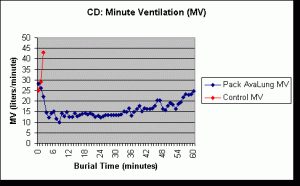
History of breathing rate during burial with AvaLung (blue) and without (red). Notice how the breathing rate starts high (panic at being buried), then settles, then creeps up as CO2 increases.
Also notice how quickly "panic" sets in
without the AvaLung (red).
Asphyxia can be caused by 1) the airway being packed with snow, 2) the weight of snow preventing chest expansion, thereby impairing breathing, 3) the simultaneous reduction of available oxygen and increase of carbon dioxide in the snowpack, and 4) the formation of an ice mask around the nose and mouth preventing air diffusion. If you’re buried and not killed by trauma, you have a 92% chance of survival if extricated within 15 minutes. That drops to to 30% at 35 minutes.
At sea level, air is a mixture of nitrogen (N), almost 79%, and oxygen (O2), 21%. There are also trace amounts of other chemicals, notably 0.03% carbon dioxide (CO2). However, when we exhale, our body has burned up some of the oxygen, so the mixture changes to 16% O2, and 5% CO2.
Now restrict the airspace that you breath from, like in an avalanche, and you can see that the levels of CO2 and O2 will invert rapidly. The smaller the airspace, the faster the oxygen is reduced.
In this new version, the AvaLung is integrated with a pack. This has a two-fold advantage. By integrating with a pack, the physical separation of inhaled from exhaled air is increased, theoretically increasing survival time. Air is inhaled above the left shoulder, and exhaled through a port in the opposite, lower-right corner of the pack.
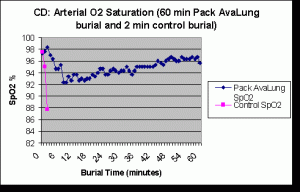
Oxygen saturation in the bloodstream during a
1-hour burial with (blue) an AvaLung versus
without one (red).
Even with all these wonderful assurances, my burial experience could hardly be called fun. Despite the voluntary and controlled nature of it all, I was surprised at how quickly panic and claustrophobia arose as the snow piled around and over me. And I’m not claustrophobic, nor prone to panic. I was as comfortable as one could be while being buried, yet I still had to fight to remain calm while the pressure of the snow gripped my body and psyche. The medical monitors revealed what I felt. My heart raced 90-plus beats a minute while my breathing increased in volume and rate. After a few minutes I learned to trust the AvaLung and began to make peace with immobility. After all, it was only going to be for an hour.
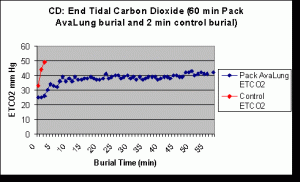
Presence of CO2 in the bloodstream during a 1-hour burial
with (blue) an AvaLung versus without (red) one.
Throughout the next 60 minutes I asked myself over and over what it would be like to actually be caught in an avalanche. In a real avy I’d probably be wearing half the layers of clothing I had on now. I probably wouldn’t have a neoprene face mask, or be sitting comfortably upright. In a real avy I’d be “Maytagged” in a maelstrom of snow and violence with non-releasable tele bindings that would drag me to the bottom of the avy lizards’ tongue of debris. In a real avy who knows what twisted position I’d be stuck in, what skin would be exposed, what orifice would be packed with snow, what ligaments and bones might be broken, what sort of pain I’d have to contend with besides the uncertainty of rescue, and coming face to face with my Maker in short order.
Continued on page 2
Pages:
- 1
- 2

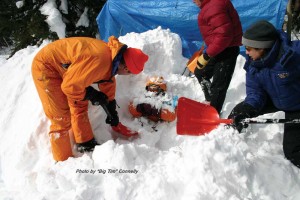
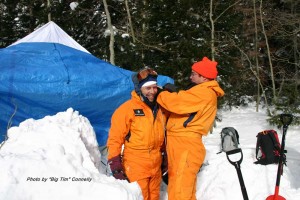
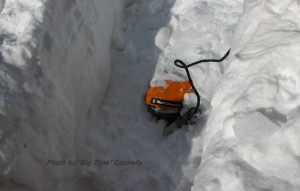
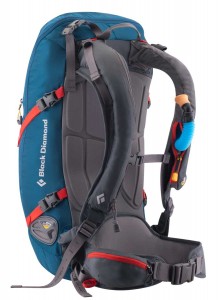
2 comments
2 pings
Great article! That brings back memories of my burial. Back in ’93/’94, I was working at Solitude for the season. One day, one of the lifties asked if I wanted a paid break from work in exchange for helping him out. He said he needed a volunteer ‘victim’ to help train his avy dog. I’m very claustrophobic. I freak out in my tent sometimes…
This thought came to mind immediately, but was just as soon brushed aside as I wasn’t a big fan of my job at the time.
So off we went. To get buried alive.
We arrived at the scene along with a few members of the ski patrol. They had a big hole dug in the snow. The only hope for surviving this ordeal was an air pocket they had dug at the bottom, off to the side.
No walkie-talkie, no beacon, no avalung, no ‘Uncle’ to cry to – just blind faith that they would retrieve me. So I crawled to the bottom of the hole and covered my head with my hands and tried to shove my head as far into the air pocket as I could. I was told the air pocket would provide me with 15 -20 minutes of air.
Oh, crap…
Then they started to cover my 8 foot deep hole with snow.
I couldn’t move. Don’t freak out, don’t freak out, don’t freak out!
My original thought was that this was going to be a cool experiment in mind control. “I can do this.”
Then the paranoia started. What the Hull was I thinking?!
So very dark. Complete silence. Don’t freak out man. Hours passed. So this is how they get rid of employees. What if they can’t find me? Where is that damn dog?!
Several more hours passed. I was finding it extremely difficult to maintain my sanity. There was nothing I could do. At least when I freak out in my tent, I can talk myself down by attempting to follow protocol – stop trying to frantically find the zipper for the door and look for your headlamp. Calm down. Breath.
This time, I was trapped. For real. Well, I thought to myself, you got what you asked for. A very real mind experiment.
I was failing.
By now, my mind was about to explode. The darkness was not only all around me, but it was in my mind. Then I heard something.
The sound startled me and brought me back from the depths of my mind warp. Now some light and the most beautiful sound – the dog’s heavy breathing. All of a sudden the light came streaming in and I could see the dogs nose! I was soon on top of the snow and out of the hole. I was ecstatic! But it was nothing compared to the dog. She was flipping out.
Running around in circles and coming back to me and licking my hands, only to run around again, then jump on me, knocking me down and slobbering all over my face.
It was awesome to see how excited and happy the dog was!
The dog was brought in by snowmachine from a mile away. I was told I was buried for seven minutes.
What?! Only seven minutes?! I swear it felt like an eternity.
Then they asked if I wanted to do it again.
Um…uh,… OK!
Another lift ride to a different ‘scene’ and we did the charade all over again. I thought that this time it would be easier.
It wasn’t.
Same experience, only 100 times worse. Seriously.
By the time the dog found me I was almost in tears.
They told me the dog was having trouble finding me. I was buried for 15 minutes. I’ll never do that again!
But it was a trip to see the dog so damn happy when she found me!
Almost made it worth it.
———————-
Very interesting info on the stats of your burial Dostie. Thanx for that.
Author
Your experience sounds a lot scarier than mine.
[…] Related Posts Canadian study reduces avalanche survival time Buried Alive […]
[…] seen is to instill fear, either through a real close call or a controlled simulation, like being buried with an avalung for at least five minutes, 15 if you dare, or doing a real dig for a full sized dummy two meters […]